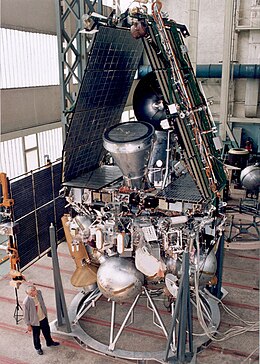Mars 96
 |
|
| Mission type | Mars Orbiter Lander Penetrator |
|---|---|
| Operator | Rosaviakosmos |
| COSPAR ID | 1996-064A |
| Mission duration | Launch failure |
| Spacecraft properties | |
| Launch mass | 6,180 kilograms (13,620 lb) |
| Start of mission | |
| Launch date | November 16, 1996, 20:48:53 UTC |
| Rocket | Proton-K/D-2 |
| Launch site | Baikonur 200/39 |
| Contractor | VKS |
| End of mission | |
| Decay date | 18 November 1996 |
| Orbital parameters | |
| Reference system | Geocentric |
| Regime | Low Earth |
Mars 96 (sometimes called Mars 8) was a failed Mars mission launched in 1996 to investigate Mars by the Russian Space Forces and not directly related to the Soviet Mars probe program of the same name. After failure of the second fourth-stage burn, the probe assembly re-entered the Earth's atmosphere, breaking up over a 200-mile long portion of the Pacific Ocean, Chile, and Bolivia. The Mars 96 spacecraft was based on the Phobos probes launched to Mars in 1988. They were of a new design at the time and both ultimately failed. For the Mars 96 mission the designers believed they had corrected the flaws of the Phobos probes, but the value of their improvements was never demonstrated due to the destruction of the probe during the launch phase.
It was, however, a very ambitious mission and the heaviest interplanetary probe launched up to that time. The mission included an orbiter, surface stations and surface penetrators. The mission included a large complement of instruments provided by France, Germany, other European countries and the United States. Similar instruments have since been flown on Mars Express, launched in 2003. Its project scientist was Alexander Zakharov.
Mars 96 was intended to solve several problems concerning our understanding of Mars. The scientific goal of the mission was to analyze the planet's evolutionary history of its surface, atmosphere, and inner structure. Other studies during cruise, such as astrophysical studies were to be made. They can be broken down into several categories.
Studies of the Martian surface were to include a global topographical survey, mineralogical mapping, soil composition, and studies of the cryolithozone and its deep structure.
Studies of the atmosphere were to include studies of the climate, abundance of certain elements, ions, and chemicals such as water, carbon dioxide, ozone, and others, general global monitoring, pressure variations over time, and characterization of aerosols.
Studies of planet structure were to find the thickness of the crust, study the Martian magnetic field, study of thermal flux, search for the possibility of active volcanoes, and study seismic activity.
...
Wikipedia
